Module 3 Body Language and Non-Verbal Communication Reading and vocabulary
文档属性
| 名称 | Module 3 Body Language and Non-Verbal Communication Reading and vocabulary |  | |
| 格式 | rar | ||
| 文件大小 | 1.8MB | ||
| 资源类型 | 教案 | ||
| 版本资源 | 外研版 | ||
| 科目 | 英语 | ||
| 更新时间 | 2011-05-20 10:39:13 | ||
图片预览




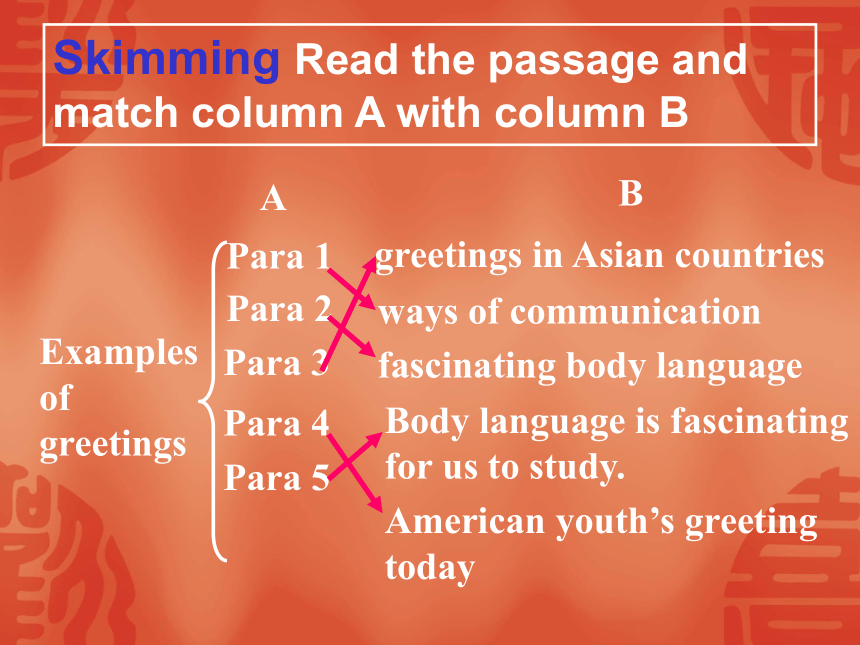
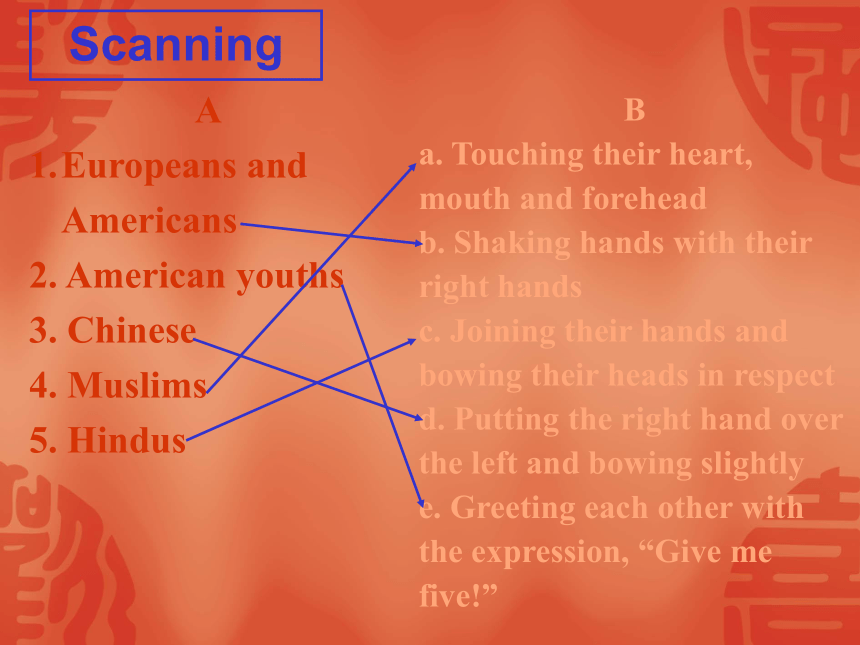
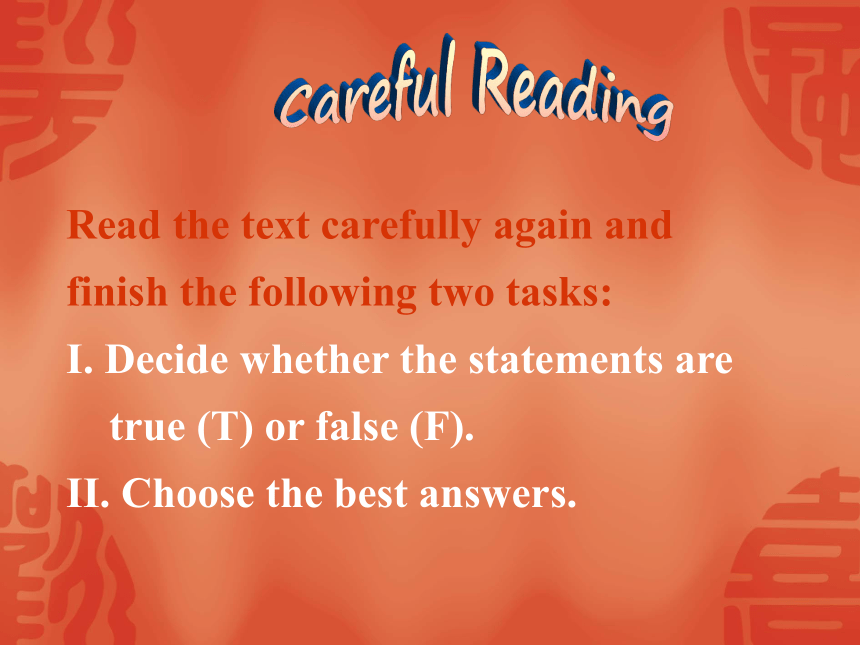
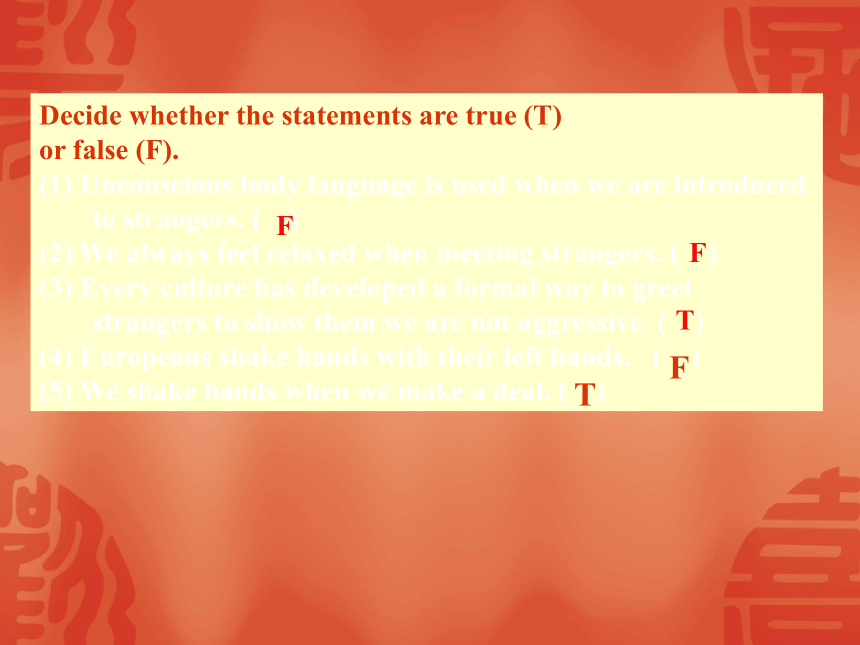
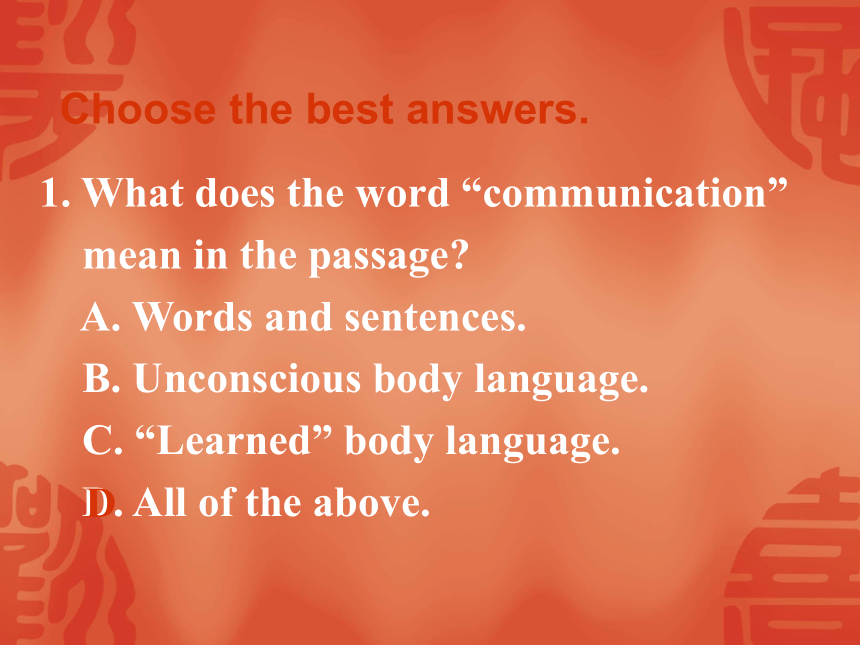
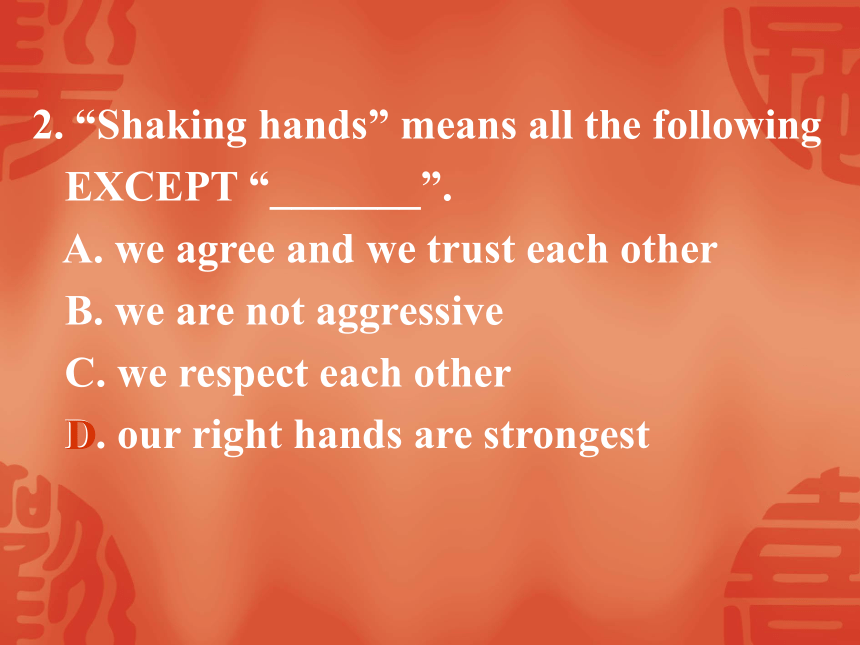
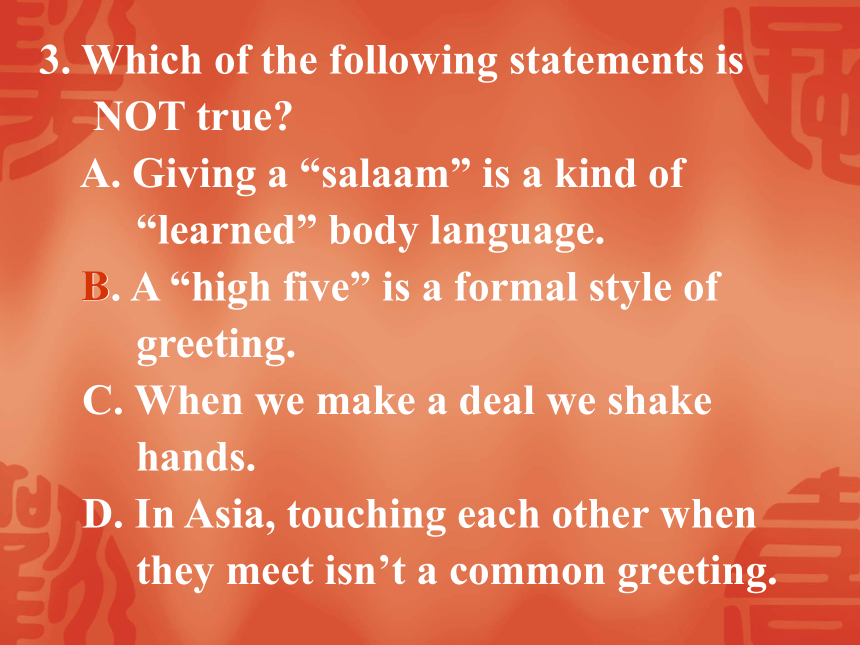
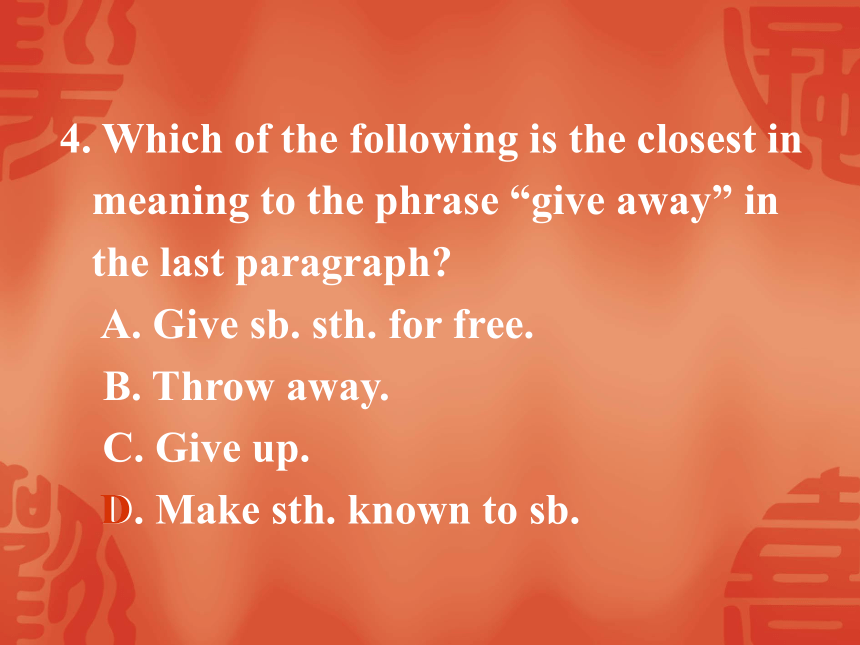
文档简介
(共43张PPT)
外研版
高一年级(必修4)
Module 3
Reading and vocabulary
Look at the following pictures and guess what we will learn in the class.
Read the text quickly and choose the best title.
1 Saying It Without Words
2 When in Rome, Do as the Romans
Do 入乡随俗
3 Greetings Around the World
4 Read My Mind
Skimming Read the passage and match column A with column B
Examples
of greetings
Para 1
Para 2
Para 3
Para 4
Para 5
A
B
greetings in Asian countries
ways of communication
fascinating body language
Body language is fascinating
for us to study.
American youth’s greeting
today
A
Europeans and Americans
2. American youths
3. Chinese
4. Muslims
5. Hindus
B
a. Touching their heart, mouth and forehead
b. Shaking hands with their right hands
c. Joining their hands and bowing their heads in respect
d. Putting the right hand over the left and bowing slightly
e. Greeting each other with the expression, “Give me five!”
Scanning
Read the text carefully again and
finish the following two tasks:
I. Decide whether the statements are true (T) or false (F).
II. Choose the best answers.
Decide whether the statements are true (T)
or false (F).
(1) Unconscious body language is used when we are introduced to strangers. ( )
(2) We always feel relaxed when meeting strangers. ( )
(3) Every culture has developed a formal way to greet strangers to show them we are not aggressive. ( )
(4) Europeans shake hands with their left hands. ( )
(5) We shake hands when we make a deal. ( )
F
F
T
F
T
What does the word “communication”
mean in the passage
A. Words and sentences.
B. Unconscious body language.
C. “Learned” body language.
D. All of the above.
Choose the best answers.
D
2. “Shaking hands” means all the following EXCEPT “_______”.
A. we agree and we trust each other
B. we are not aggressive
C. we respect each other
D. our right hands are strongest
D
3. Which of the following statements is
NOT true
A. Giving a “salaam” is a kind of
“learned” body language.
B. A “high five” is a formal style of
greeting.
C. When we make a deal we shake
hands.
D. In Asia, touching each other when
they meet isn’t a common greeting.
B
4. Which of the following is the closest in meaning to the phrase “give away” in the last paragraph
A. Give sb. sth. for free.
B. Throw away.
C. Give up.
D. Make sth. known to sb.
D
5. What’s the author’s purpose in
writing the passage
A. To teach us how to greet others.
B. To advise us to use “learned” body
language.
C. To offer us some information about
“learned” body language.
D. To let us know why we shake
hands when we meet.
C
Fill in the form:
People How they greet traditionally
Chinese
Muslims
Hindus
Put the right hand over the left and bow slightly.
Touch their heart, mouth and forehead. (salaam)
Join their hands and bow
their heads in respect.
Let’s imitate the ways of greeting of
the different people, such as
Eurpeans, Chinese, Muslims, Hindus,
American youths.
American youths
Chinese
Muslims
Europeans and Americans
We use both _____ and _____________ to express our thoughts and opinions and to ____________ with other people. Just like spoken language, body language _____ from culture to culture.
Filling the blanks
words
body language
communicate
varies
Every culture has developed a formal way to ____ strangers. Traditionally, Europeans and Americans ___________. They do this with the _____ hand. That means I trust you. I’m not carrying a __________ weapon.
Greetings in _____ countries do not ______ touching the other person, but they always involve the hands.
greet
shake hands
right
threatening
Asian
involve
Today American youths often greet each other with the expression, “___________!” Body language is fascinating for anyone to study.
People ___a____ much more by
their _______ than by their words.
Give me five
give
away
gestures
communications
body
language
words and
sentences
______ words
written words
unconscious
body positions
__________ body language
_______body language
learned
spoken
Language points
Although these are very important, we communicate with more than just spoken and written words. 尽管这些很重要, 但我们并不只是通过口头和书面语言交流。
more than “不只是”, “远甚于”
It is more than a museum; it’s a school.
2. Like other animals, we are on guard until we know it is safe to relax.
我们感觉到很安全才会放松, 否则将一直处于戒备状态。
be on guard 有警惕, 心存戒备
3. If our right hand is busy greeting someone, it cannot be holding a weapon.
如果我们的右手忙着和别人打招呼, 就不可能握有武器了。
be busy doing sth / be busy with sth. 忙着做某事
4. Nowadays, it is quite a common greeting.
现在, 它是一种很常见的打招呼方式。
quite通常放在冠词a/an 的前面。
quite a success 非常成功
Word study
1. vary
【语境展示】
1) People’s reactions to the drug vary
widely.
人们对药品的反应差异很大。
2) The samples varied in quality but
were generally acceptable.
样品质量不等,但总体来说还能接受。
3) The colours of tree leaves vary with
the season.
树叶的颜色随着季节的变化而改变。
4) Ticket prices vary from one airline to
another.
机票的价格在不同的航空公司之间有
差别。
5) The doctor tries to vary the patient’s
diet.
医生试图调整病人的饮食。
【总结归纳】
vary
vi. 不同; 改变; 变化, 常用搭配有vary in在……方面不同;vary with随着……而变化;vary from不同于……; vary from ... to ... 由……到……情况不等; vary between ... and ... 由……到……情况不等。
vt. 变更; 使变化。
【链接】
variable (likely to change often) adj. 可变的;变化无常的
various (several different types of something) adj. 各种各样的;不同的
varied (many different kinds of things or people) adj. 不同的, 各式各样的
variety n. 多样化,种类
variation n. 变化
【即学即练】 根据所给的汉语提示完成下列句子,每空一词。
1. 这些花的颜色和大小都不相同,但都很
漂亮。
The flowers ____ __ _____ ____ ____
but all of them are beautiful.
2. 这家宾馆每个房间的费用由20美元到30
美元不等。
The charge for a room in this hotel
_____ _________ $20 and $30.
varies between
vary in colour and size
3. 一般来说,水果和蔬菜的价格随季
节变化而变化。
Generally speaking, prices of fruit
and vegetables _____ _____ the
season.
varies with
spread
【语境展示】
1) He spread a mat on the floor.
他在地板上铺上了一张席子。
2) The city has spread quickly.
这城市扩展得很快。
3) A wide stretch of land spread in front
of us.
展现在我们面前的是一片广阔的土地。
4) The news quickly spread abroad.
消息迅速传开。
5) The fire spread quickly through the
forest.
大火迅速在整个林区蔓延。
6) The spread of the disease frightened
the villagers.
疾病的蔓延使村民害怕。
【总结归纳】
spread vt. 铺开;展开;伸开。
vi. 伸展,延伸;传播,传开; 蔓延, 传染。
n. 传播,传布。
【拓展】
spread out 张开;伸开;铺开。如:
He spread out his hands and found the coin had been gone.
他伸开手发现硬币不见了。
【即学即练】英译汉。
1. Mom spread a new tablecloth on the
table.
2. She was told not to spread this secret
around.
妈妈铺了一张新的桌布在桌子上。
她被告知不要把这个秘密传出去。
3. The fire spread from the factory to the
buildings nearby.
大火从工厂蔓延到附近的建筑。
SENTENCE EXPLANATIONS
1. We see examples of unconscious body language very often, yet there is also “learned” body language, which varies from culture to culture.
= Though examples of unconscious body language are often seen, yet there is different “learned” body language in different cultures.
本句是一个并列句。连词yet在句中表示“然而”,连接两个并列的分句。yet前的分句是一个主谓宾结构的简单句,yet后的分句是一个含有定语从句的复合句,其中which引导的非限制性定语从句修饰“learned” body language。
2. Like other animals, we are on guard
until we know it is safe to relax.
= We human beings as well as other
animals pay more attention to what is
happening in order to avoid danger
before we feel safe and relaxed.
本句是一个复合句。Like other animals是介词短语作状语;until引导的是时间状语从句,其中know后面的it is safe to relax是省略了引导词that的宾语从句。
3. Muslims give a “salaam”, where they touch their heart, mouth and forehead.
= When Muslims salaam someone, they touch their heart, mouth and forehead.
本句是一个复合句。where引导的非限制性定语从句修饰先行词“salaam”,where在定语从句中作状语。salaam在这里作名词,意为“额手礼”,它也可用作动词,表示“行额手礼”。
1. Complete the exercises related to
Vocabulary and Reading in the
Workbook on page 80—82.
2. Greetings vary from culture to culture.
Summarize the greetings in different countries according to the passage.
外研版
高一年级(必修4)
Module 3
Reading and vocabulary
Look at the following pictures and guess what we will learn in the class.
Read the text quickly and choose the best title.
1 Saying It Without Words
2 When in Rome, Do as the Romans
Do 入乡随俗
3 Greetings Around the World
4 Read My Mind
Skimming Read the passage and match column A with column B
Examples
of greetings
Para 1
Para 2
Para 3
Para 4
Para 5
A
B
greetings in Asian countries
ways of communication
fascinating body language
Body language is fascinating
for us to study.
American youth’s greeting
today
A
Europeans and Americans
2. American youths
3. Chinese
4. Muslims
5. Hindus
B
a. Touching their heart, mouth and forehead
b. Shaking hands with their right hands
c. Joining their hands and bowing their heads in respect
d. Putting the right hand over the left and bowing slightly
e. Greeting each other with the expression, “Give me five!”
Scanning
Read the text carefully again and
finish the following two tasks:
I. Decide whether the statements are true (T) or false (F).
II. Choose the best answers.
Decide whether the statements are true (T)
or false (F).
(1) Unconscious body language is used when we are introduced to strangers. ( )
(2) We always feel relaxed when meeting strangers. ( )
(3) Every culture has developed a formal way to greet strangers to show them we are not aggressive. ( )
(4) Europeans shake hands with their left hands. ( )
(5) We shake hands when we make a deal. ( )
F
F
T
F
T
What does the word “communication”
mean in the passage
A. Words and sentences.
B. Unconscious body language.
C. “Learned” body language.
D. All of the above.
Choose the best answers.
D
2. “Shaking hands” means all the following EXCEPT “_______”.
A. we agree and we trust each other
B. we are not aggressive
C. we respect each other
D. our right hands are strongest
D
3. Which of the following statements is
NOT true
A. Giving a “salaam” is a kind of
“learned” body language.
B. A “high five” is a formal style of
greeting.
C. When we make a deal we shake
hands.
D. In Asia, touching each other when
they meet isn’t a common greeting.
B
4. Which of the following is the closest in meaning to the phrase “give away” in the last paragraph
A. Give sb. sth. for free.
B. Throw away.
C. Give up.
D. Make sth. known to sb.
D
5. What’s the author’s purpose in
writing the passage
A. To teach us how to greet others.
B. To advise us to use “learned” body
language.
C. To offer us some information about
“learned” body language.
D. To let us know why we shake
hands when we meet.
C
Fill in the form:
People How they greet traditionally
Chinese
Muslims
Hindus
Put the right hand over the left and bow slightly.
Touch their heart, mouth and forehead. (salaam)
Join their hands and bow
their heads in respect.
Let’s imitate the ways of greeting of
the different people, such as
Eurpeans, Chinese, Muslims, Hindus,
American youths.
American youths
Chinese
Muslims
Europeans and Americans
We use both _____ and _____________ to express our thoughts and opinions and to ____________ with other people. Just like spoken language, body language _____ from culture to culture.
Filling the blanks
words
body language
communicate
varies
Every culture has developed a formal way to ____ strangers. Traditionally, Europeans and Americans ___________. They do this with the _____ hand. That means I trust you. I’m not carrying a __________ weapon.
Greetings in _____ countries do not ______ touching the other person, but they always involve the hands.
greet
shake hands
right
threatening
Asian
involve
Today American youths often greet each other with the expression, “___________!” Body language is fascinating for anyone to study.
People ___a____ much more by
their _______ than by their words.
Give me five
give
away
gestures
communications
body
language
words and
sentences
______ words
written words
unconscious
body positions
__________ body language
_______body language
learned
spoken
Language points
Although these are very important, we communicate with more than just spoken and written words. 尽管这些很重要, 但我们并不只是通过口头和书面语言交流。
more than “不只是”, “远甚于”
It is more than a museum; it’s a school.
2. Like other animals, we are on guard until we know it is safe to relax.
我们感觉到很安全才会放松, 否则将一直处于戒备状态。
be on guard 有警惕, 心存戒备
3. If our right hand is busy greeting someone, it cannot be holding a weapon.
如果我们的右手忙着和别人打招呼, 就不可能握有武器了。
be busy doing sth / be busy with sth. 忙着做某事
4. Nowadays, it is quite a common greeting.
现在, 它是一种很常见的打招呼方式。
quite通常放在冠词a/an 的前面。
quite a success 非常成功
Word study
1. vary
【语境展示】
1) People’s reactions to the drug vary
widely.
人们对药品的反应差异很大。
2) The samples varied in quality but
were generally acceptable.
样品质量不等,但总体来说还能接受。
3) The colours of tree leaves vary with
the season.
树叶的颜色随着季节的变化而改变。
4) Ticket prices vary from one airline to
another.
机票的价格在不同的航空公司之间有
差别。
5) The doctor tries to vary the patient’s
diet.
医生试图调整病人的饮食。
【总结归纳】
vary
vi. 不同; 改变; 变化, 常用搭配有vary in在……方面不同;vary with随着……而变化;vary from不同于……; vary from ... to ... 由……到……情况不等; vary between ... and ... 由……到……情况不等。
vt. 变更; 使变化。
【链接】
variable (likely to change often) adj. 可变的;变化无常的
various (several different types of something) adj. 各种各样的;不同的
varied (many different kinds of things or people) adj. 不同的, 各式各样的
variety n. 多样化,种类
variation n. 变化
【即学即练】 根据所给的汉语提示完成下列句子,每空一词。
1. 这些花的颜色和大小都不相同,但都很
漂亮。
The flowers ____ __ _____ ____ ____
but all of them are beautiful.
2. 这家宾馆每个房间的费用由20美元到30
美元不等。
The charge for a room in this hotel
_____ _________ $20 and $30.
varies between
vary in colour and size
3. 一般来说,水果和蔬菜的价格随季
节变化而变化。
Generally speaking, prices of fruit
and vegetables _____ _____ the
season.
varies with
spread
【语境展示】
1) He spread a mat on the floor.
他在地板上铺上了一张席子。
2) The city has spread quickly.
这城市扩展得很快。
3) A wide stretch of land spread in front
of us.
展现在我们面前的是一片广阔的土地。
4) The news quickly spread abroad.
消息迅速传开。
5) The fire spread quickly through the
forest.
大火迅速在整个林区蔓延。
6) The spread of the disease frightened
the villagers.
疾病的蔓延使村民害怕。
【总结归纳】
spread vt. 铺开;展开;伸开。
vi. 伸展,延伸;传播,传开; 蔓延, 传染。
n. 传播,传布。
【拓展】
spread out 张开;伸开;铺开。如:
He spread out his hands and found the coin had been gone.
他伸开手发现硬币不见了。
【即学即练】英译汉。
1. Mom spread a new tablecloth on the
table.
2. She was told not to spread this secret
around.
妈妈铺了一张新的桌布在桌子上。
她被告知不要把这个秘密传出去。
3. The fire spread from the factory to the
buildings nearby.
大火从工厂蔓延到附近的建筑。
SENTENCE EXPLANATIONS
1. We see examples of unconscious body language very often, yet there is also “learned” body language, which varies from culture to culture.
= Though examples of unconscious body language are often seen, yet there is different “learned” body language in different cultures.
本句是一个并列句。连词yet在句中表示“然而”,连接两个并列的分句。yet前的分句是一个主谓宾结构的简单句,yet后的分句是一个含有定语从句的复合句,其中which引导的非限制性定语从句修饰“learned” body language。
2. Like other animals, we are on guard
until we know it is safe to relax.
= We human beings as well as other
animals pay more attention to what is
happening in order to avoid danger
before we feel safe and relaxed.
本句是一个复合句。Like other animals是介词短语作状语;until引导的是时间状语从句,其中know后面的it is safe to relax是省略了引导词that的宾语从句。
3. Muslims give a “salaam”, where they touch their heart, mouth and forehead.
= When Muslims salaam someone, they touch their heart, mouth and forehead.
本句是一个复合句。where引导的非限制性定语从句修饰先行词“salaam”,where在定语从句中作状语。salaam在这里作名词,意为“额手礼”,它也可用作动词,表示“行额手礼”。
1. Complete the exercises related to
Vocabulary and Reading in the
Workbook on page 80—82.
2. Greetings vary from culture to culture.
Summarize the greetings in different countries according to the passage.
